

Mixer mill MM 500 control - temperature control during grinding for laboratory and industrial applications
The MM 500 control is a high energy laboratory ball mill that can be used for dry, wet and cryogenic grinding with a frequency of up to 30 Hz. It is the first mixer mill in the market that allows to monitor and control the temperature of a grinding process.
THE ONLY MIXER MILL WITH TEMPERATURE CONTROL
- Max. speed 30 Hz
- Horizontal oscillation causes strong impact effects for effective sample processing
- Up to 10 mm feed size and 0.1 µm final fineness
- 2 grinding stations for jars of min. 2 ml and max. 125 ml, adapter for 18 x 2 ml single use vials
- Various possibilities for heating or cooling with thermal fluid or liquid nitrogen for cryogenic grinding, temperature regulation between -100 °C and 100 °C, monitoring of temperature
- GrindControl to measure temperature and pressure inside the jar.
- Aeriation lids to control the atmosphere inside the jar
- Bench top model, touch screen, easy jar clamping, jars can stay clamped for subsampling, storable SOPs and cycle programs, 4 different jar materials for dry and wet grinding
ADVANTAGES THROUGH DESIGN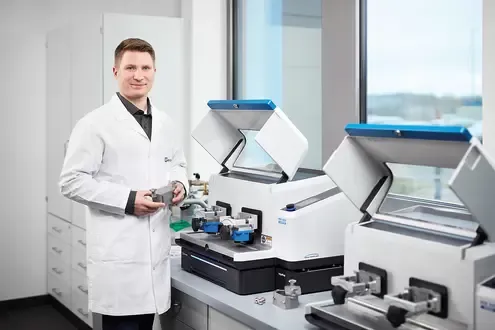
Dry, wet and cryogenic grinding with up to 30 Hz for high energy grinding
- Fast and comfortable sample processing with two screw lock jars of up to 125 ml each
- Patented hermetically closed fluid system ensures the safe operation of thermal fluids
- Wide range of accessories available, including ventilation lids and heavy-metal-free grinding jars (also for cryogenic grinding)
- Ergonomic jar clamping, low noise level, user friendly parameter setting via touch display
TEMPERATURE MONITORING AND CONTROL
- Continuous temperature monitoring throughout a grinding process
- Cooling and heating in a range from - 100 to 100 °C
- Operation is possible with liquid nitrogen or other thermal fluid
- High flexibility in terms of selecting a tempering device for temperature regulation (LN2 supply, cryostat, chiller, …).
- Low temperature grinding is possible without LN2
CRYOPAD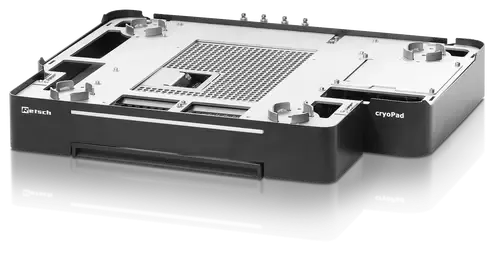
- Extension device cryoPad is required for the operation with LN2
- The cryoPad regulates the flow of LN2 through the thermal plate
- The cryoPad technology allows to select and maintain a specific cooling temperature in the range between - 100 and 0 °C while using LN2
TEMPERATURE REGULATION BASED ON THERMAL PLATES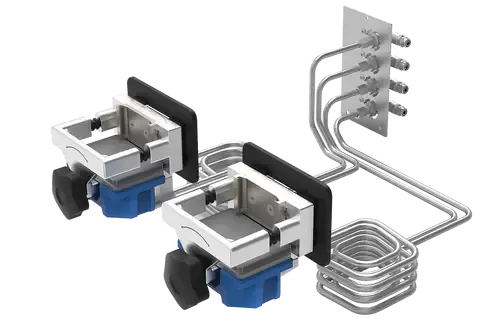
The cooling and heating of the sample material is realized with the patented concept of thermal plates, making sample cooling with, e. g., open liquid nitrogen baths or dry ice obsolete. For tempering, the grinding jars are simply placed on top of the thermal plates. When the grinding jars come in contact with the thermal plates, heat is effectively transferred from or to the jars via the tempering device. The patented hermetically sealed fluid design allows to operate the mill with different thermal fluids, ensuring a flexible and safe temperature regulation and requiring only minimal effort for the user. Depending on the operational setup that is built up, the temperature of the thermal plates can be set in the range from - 100 to + 100 °C.
CONFIGURATIONS
To control the temperature of a grinding process, the mill needs to be connected to an external tempering device. Basically, there are two options:
1. Temperature regulation with liquid nitrogen
The mill is operated with liquid nitrogen and connected to a nitrogen tank. In this setup the mill must be extended with the optionally available extension device cryoPad. The patented PID (proportional–integral–derivative) system of the cryoPad controls the flow of liquid nitrogen and herewith the temperature of the thermal plates. In this setup, it is possible to select and maintain the temperature of the thermal plates at a specific value. The desired temperature is adjusted via the touch display and can be selected within a range from - 100 to 0 °C, in steps of 10.
Setup 1: Extension device cryoPad and LN2 tank for the operation with liquid nitrogen.
2. Cooling or heating with a liquid thermal fluid
In this setup, the mill can either be connected to a cryostat, to a chiller or to the water tap. The external tempering device regulates the corresponding thermal fluid to a defined temperature and the thermal fluid transfers this temperature to the thermal plates. As during a grinding process, a significant amount of heat may also develop inside the jar, the temperature of the thermal plates may be manipulated. To sum up, the actual temperature of the thermal plates depends on both, on the temperature of the thermal fluid and on grinding parameters, like frequency, time, jar volume, size of grinding balls. For a maximum control of the grinding process, the actual temperature of the thermal plates is continuously monitored in the touch display.
Setup 2: Operation with an external tempering device; e.g. water tap, chiller or thermostat.
APPLICATION EXAMPLES
- Preserving temperature-sensitive analytes (like volatile substances or pharmaceutical and food ingredients)
- Embrittlement
- Wet grinding below room temperature
- Mechanochemistry
- Paste making (in food industry)
- Intensifying mechanochemical reactions
PRESERVING TEMPERATURE-SENSITIVE ANALYTES
Grinding of coffee beans at low temperatures for natural substance analysis. | CRYOGENIC GRINDING
|
WET GRINDING < 30 °C
| MECHANOCHEMISTRY
|
TYPICAL SAMPLE MATERIALS
TECHNICAL DATA
MIXER MILL MM 500 CONTROL| Applications | mechanochemistry, mechanical alloying, size reduction, mixing, homogenization, cryogenic grinding |
| Field of application | agriculture, biology, chemistry / plastics, construction materials, engineering / electronics, environment / recycling, food, geology / metallurgy, glass / ceramics, medicine / pharmaceuticals |
| Feed material | hard, medium-hard, soft, brittle, elastic, fibrous |
| Size reduction principle | impact, friction |
| Material feed size* | <= 10 mm |
| Final fineness* | ~ 0.1 µm |
| Batch size / feed quantity* | max. 2 x 45 ml |
| Grinding chamber volume | max. 2 x 125 ml |
| No. of grinding stations | 2 |
| Vibrational frequency | 3 - 30 Hz (180 -1800 min-1) |
| Setting of temperature setpoint | digital, 0 ... -100 °C (only with cryoPad) |
| Setting of sample cooling time | digital, 0 ... 60 min (only with cryoPad) |
| Setting of grinding time | digital, 10 s - 8 h |
| Total grinding time | 99 h |
| Storable SOPs | 12 |
| Number of storable cycle programs | 4 (with 99 repeats) |
| Typical mean grinding time | 30 s - 2 min |
| Dry grinding | yes |
| Wet grinding | yes |
| Cryogenic grinding | yes |
| Type of grinding jars | screw-lock jar with integrated safety closure devices, multi cavity jar, adapter for safe-lock reaction vials |
| Material of grinding tools | hardened steel, stainless steel, tungsten carbide, zirconium oxide |
| Grinding jar sizes | 10 ml / 25 ml / 50 ml / 80 ml / 125 ml |
| Electrical supply data | 100-120 V, 50/60 Hz; 200-230 V, 50/60Hz |
| Power connection | 1-phase |
| Protection code | IP 30 |
| Power consumption | 750 W |
| W x H x D closed | 690 x 375 x 585 mm |
| W x H x D closed with cryoPad | 690 x 485 x 585 mm |
| Net weight | ~ 63 kg |
| Standards | CE |
| Connection thread size device input | G 1/4" (inner thread) |
| Connection thread size tubing set | G 3/8" (outer thread) |
| Permissible operating pressure cooling device (provided by customer) | 0 ... 5 bar |
| typical pressure range of continous cooling unit e.g. cryostat | 1 ... 2 bar |
| permissible pressure range of LN2 supply | 1.2 ...1.4 bar |
| Permissible fluids | water, water-glycole mixture, thermal oil, liquid nitrogen |
| Thermal applications | embrittling, cooling, heating, temperature control |
| temperature range of fluids | +100 °C ... -196 °C |
| temperature range of cooling plates | +100 °C ... -100 °C |
| Applications | cryogenic grinding with liquid nitrogen |
| Interface | RS-232 (MM 500 control) |
| Communication connection | via included connection cable |
| Power supply | via external power supply |
| Electrical supply data (input external power supply) | 100-230V, 50/60 Hz |
| External power supply classification | Medical grade isolation level |
| Electrical supply data (input cryoPad) | 24 V, 1 A |
| Accessories | LN2 Autofill 150L, LN2 Autofill 50L |
| LED status light | yes |
| W x H x D | 670 x 110 x 590 mm |
| Net weight | ~ 26 kg |
| Standards | CE |
| Connection thread size device input | G 1/4" (inner thread) |
| Connection thread size of stainless steel tubing adapter | UNF 3/4" |
| Permissible pressure range of LN2 supply | 1.2 ...1.4 bar |
| Permissible fluids | Liquid nitrogen |
| Emissions | Liquid nitrogen gas, condensation |
| Connection | via included tubing set |
| Exhaust outlet | via included Exhaust adapter and aluminum corrugated tube |
| temperature range of fluids | -196 °C |
| temperature control algorithm | PID temperature control |
| Setting of temperature setpoint | digital, 0 ... -100 °C |
| Setting of sample cooling time | digital, 0 ... -60 °C |

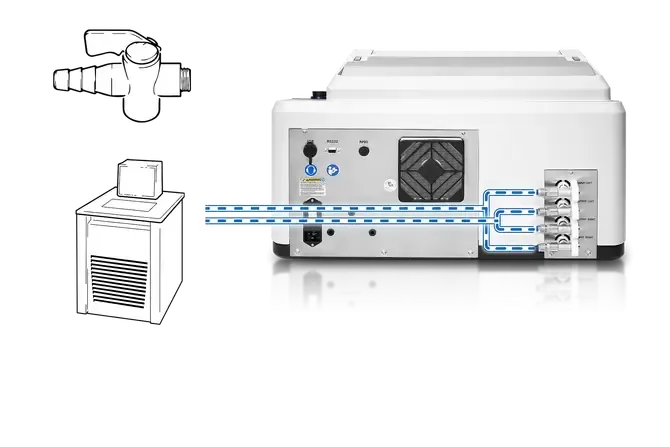
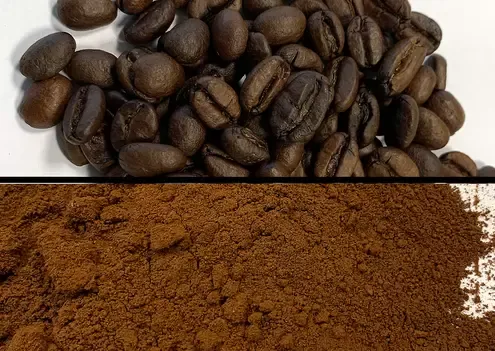
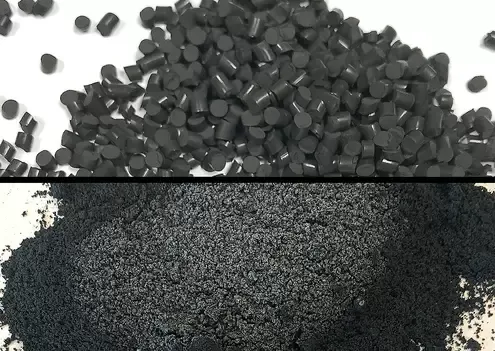 Fast milling of black Flurocarbon rubber (FKM) by embrittling the sample in two 125 ml jars at – 100 °C.
Fast milling of black Flurocarbon rubber (FKM) by embrittling the sample in two 125 ml jars at – 100 °C. 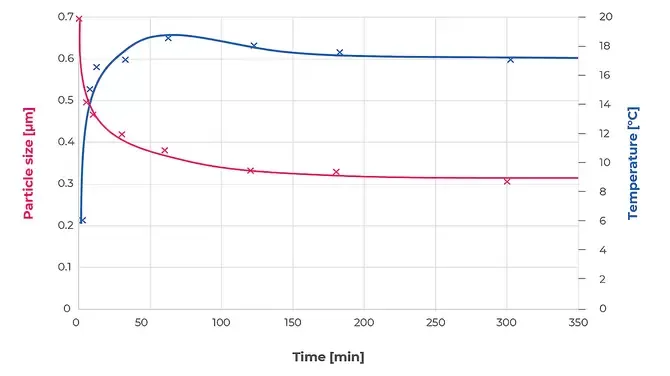 Particle size and temperature development for TiO2 in a wet grinding process with 30 Hz and 2 x 125 ml jars
Particle size and temperature development for TiO2 in a wet grinding process with 30 Hz and 2 x 125 ml jars  Fast formation of ZIF-8 at 30 Hz. By keeping the temperature below 0 °C, the formation of non-porous Zeolitic Imidazolate Frameworks (ZIF-8) is inhibited.
Fast formation of ZIF-8 at 30 Hz. By keeping the temperature below 0 °C, the formation of non-porous Zeolitic Imidazolate Frameworks (ZIF-8) is inhibited.